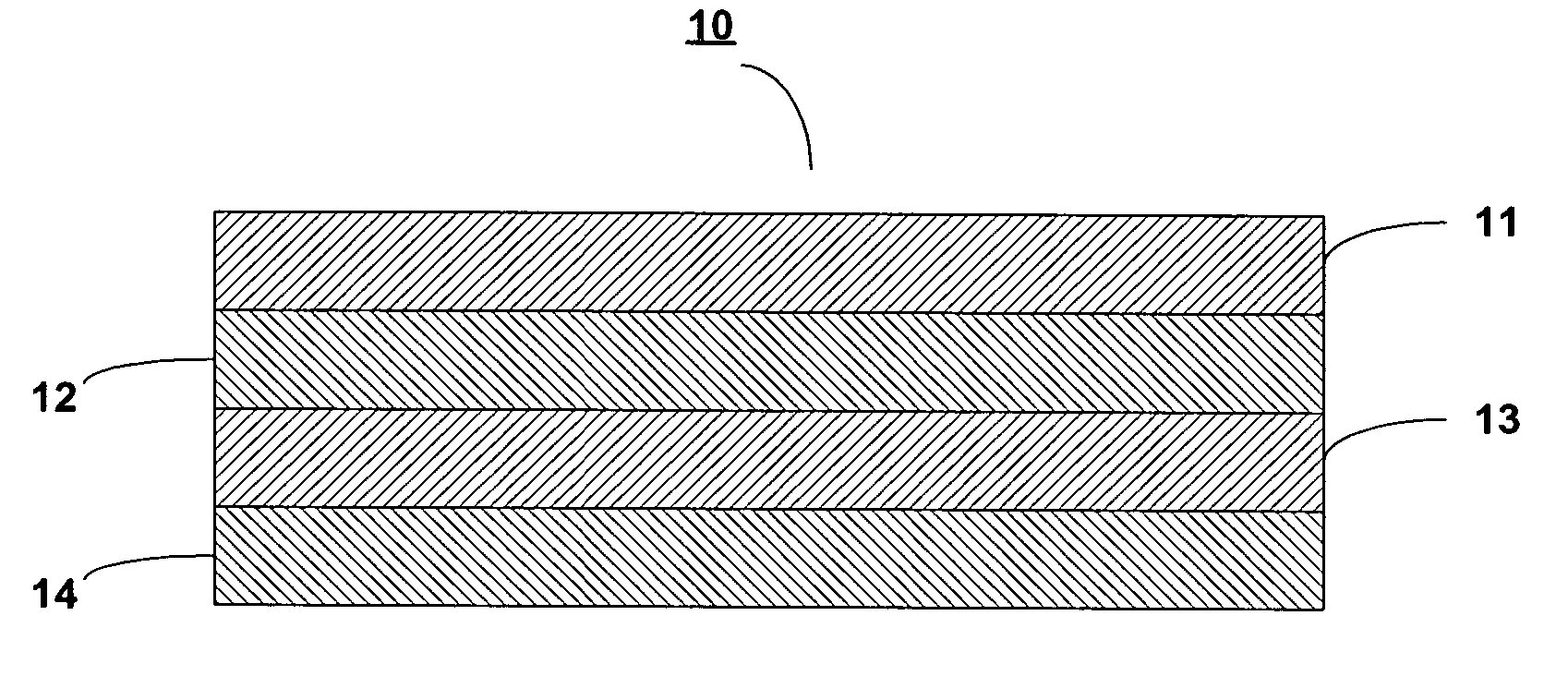Polyester and polyamide blend containing article for packaging a CO2 respiring foodstuff
a technology of co2 and food products, applied in the field of packaging co2 respiring foodstuffs, can solve the problems of difficult to adjust co2 permeability for use on different cheeses, time-consuming and expensive, and complex manufacturing of these films, and achieves good machinability, good optical properties, and wide heat sealing formation range.
- Summary
- Abstract
- Description
- Claims
- Application Information
AI Technical Summary
Benefits of technology
Problems solved by technology
Method used
Image
Examples
example 1
[0130] The first polymeric layer comprised a blend of 90% (by weight relative to the total weight of the first layer) of polyethylene terephthalate having a crystalline density of 1.4 g / cm3, a melting point of 250° C., which is sold under the trademark VORIDIAN™ PET 9663 from Eastman Chemical Company, Kingsport, Tenn., U.S.A., 9% (by weight relative to the total weight of the first layer) poly(m-xylyleneadipamide) and 1% (by weight relative to the total weight of the first layer) process additives. The first layer had a thickness of approximately 0.6 mil. and was adhesive laminated using a two-part polyurethane adhesive to second layer of biaxially oriented polypropylene having a thickness of about 0.5 mil. In Example 1, a third layer of ethylene vinyl acetate copolymer having an approximate thickness of 1.5 mil. was then extrusion coated onto the second layer of the two-layer adhesive laminate. The ethylene vinyl acetate copolymer comprised 18% (by weight) vinyl acetate content, a ...
example 2
[0131] Polyethylene terephthalate supplied as grade 9663 by Voridian, a business unit of Eastman Chemical Company, Kingsport, Tenn., served as the PET component of the blend. MXD6 grade RENY 6007, provided by Mitsubishi Gas Chemical Company, Inc., Tokyo, Japan was the polyamide used in the blend. An antiblocking agent was used to controllably roughen the film surface and provide for an appropriate COF of the finished film product.
[0132] The Voridian 9663 PET was dried at about 160° C. to a water content of less than 50 ppm using desiccated air with a dew point of about −34° C. The Mitsubishi Gas Chemical RENY 6007 MXD6 was supplied dry but nonetheless was further dried at about 65° C. with desiccated air. The antiblocking agent was not dried prior to processing.
[0133] The PET, MXD6 and antiblocking agent were delivered to a tumble blender in batches of about 25 kg in a ratio of 90:9.5:0.5. The dried resins were measured gravimetrically and automatically delivered to the blender wi...
example 3
[0139] Manufacture of a film was carried-out identically by the method described in the previous example. The composition of the film was adapted to improve the flex crack resistance of the film. To this end, a blend of Mitsubishi RENY 6007 MXD6 and an atactic propylene ethylene copolymer supplied by Eastman Chemical Company as Eastoflex D-180 was made as described above. The specific composition of the blend was 90% MXD6 and 10% atactic propylene ethylene copolymer. The pelletized blend was prepared by melt mixing the two components in a 50 mm, co-rotating twin screw extruder, forming continuous strands with an appropriately-shaped die, cooling the strands in a water bath, removing excess water with an air knife and chopping the strands into pellets with a rotating knife-style pelletizer.
[0140] Film was made that included the MXD6 / atactic propylene ethylene copolymer blend essentially according to the method described above. The composition of the film was 89.5% Voridian 9663 PET,...
PUM
| Property | Measurement | Unit |
|---|---|---|
| thickness | aaaaa | aaaaa |
| haze | aaaaa | aaaaa |
| weight % | aaaaa | aaaaa |
Abstract
Description
Claims
Application Information
 Login to View More
Login to View More - R&D
- Intellectual Property
- Life Sciences
- Materials
- Tech Scout
- Unparalleled Data Quality
- Higher Quality Content
- 60% Fewer Hallucinations
Browse by: Latest US Patents, China's latest patents, Technical Efficacy Thesaurus, Application Domain, Technology Topic, Popular Technical Reports.
© 2025 PatSnap. All rights reserved.Legal|Privacy policy|Modern Slavery Act Transparency Statement|Sitemap|About US| Contact US: help@patsnap.com


